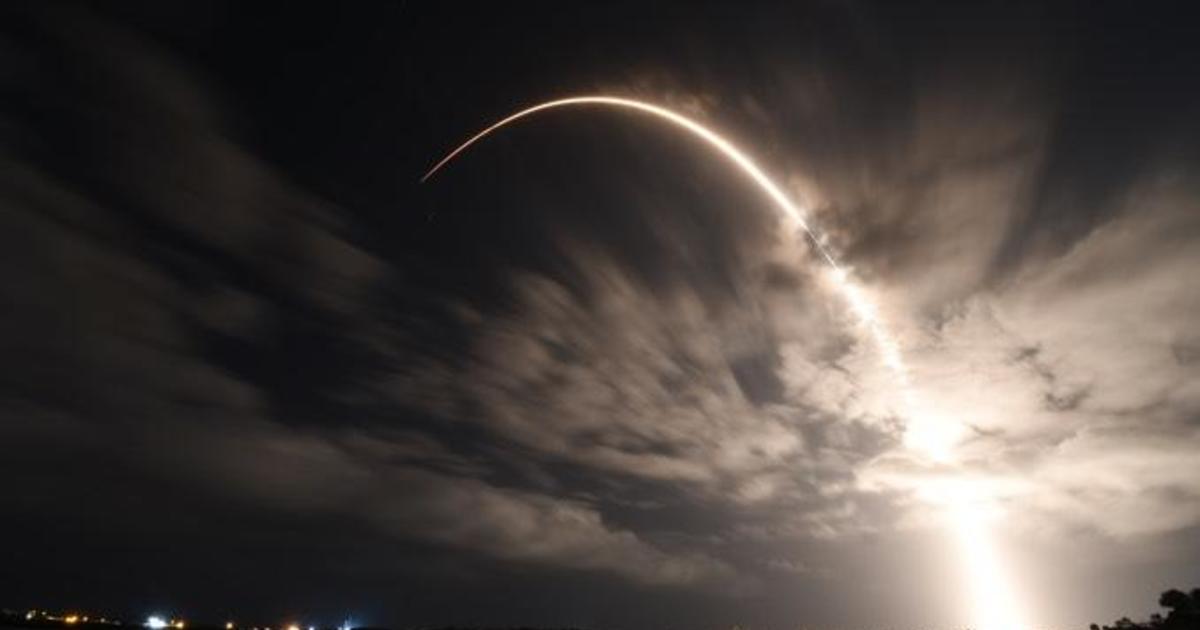A time exposure captures the fiery trajectory of a SpaceX Falcon 9 rocket climbing away from the Cape Canaveral Air Force Station carrying 60 Starlink internet relay satellites. It was the company’s 23rd launch so far this year, the 100th for the workhorse Falcon 9 since the rocket’s debut in 2010 and a record seventh flight for the booster’s first stage.
William Harwood/CBS News
SpaceX fired off a Falcon 9 rocket from Florida on Tuesday night, marking the company’s 100th overall and 23rd so far this year. The rocket boosted off another set of 60 Starlink internet satellites into orbit using a first stage making a record seventh flight.
The latest batch of Starlinks pushed the total number launched to date to 955 as SpaceX continues building out a globe-spanning constellation of internet relay satellites designed to provide broadband services to subscribers anywhere on the planet. Thousands more satellites are planned.
The well-traveled booster’s nine engines ignited at 9:13 p.m. ET, throttled up to full power and quickly pushed the slender rocket away from pad 40 at the Cape Canaveral Air Force Station atop a brilliant jet of flaming exhaust.
Liftoff came three days later than planned because of high winds that delayed a first stage engine test firing and rough weather in the off-shore booster recovery zone.
But it was clear sailing Tuesday as the 30-story-tall Falcon 9 raced away over the Atlantic Ocean, putting on a spectacular early evening show for area residents and tourists.
The rocket’s first stage was making a record seventh trip out of the lower atmosphere, becoming SpaceX’s Falcon 9 “fleet leader.” Two-and-a-half minutes after launch, it’s nine Merlin 1D engines shut down and it separated from the Falcon 9’s second stage.
While the second stage continued toward orbit on the power of its single vacuum-rated engine, the first stage plunged back to Earth, guiding itself to a picture-perfect landing on a waiting SpaceX droneship. Touchdown marked the company’s 67th successful booster recovery, its 46th at sea and its second landing in two days.
Elon Musk, SpaceX founder and chief designer, said Falcon 9 “block 5” first stages should be able to fly up to 10 times without a major overhaul and up to 100 times with scheduled inspections and maintenance.
In any case, a few seconds after the booster touched down on the “Of Course I Still Love You” droneship, the Falcon 9’s second stage shut down and six minutes after that, the 60 Starlink internet relay satellites were released to fly on their own.
SpaceX currently is testing initial Starlink service across parts of Canada and the northern U.S. The company has regulatory approval to launch thousands of satellites in six orbital planes to provide seamless broadband to commercial receivers anywhere on Earth, not just the higher latitudes now being serviced.
Astrophysicist Jonathan McDowell, an independent space analyst, said it appears that 54 Starlinks have been deliberately deorbited to date, another six have re-entered after possible failures and 18 others do not seem to be maneuvering. By that count, 817 Starlinks were believed to be operational going into Sunday’s launch.
